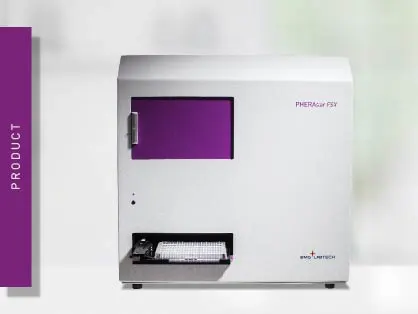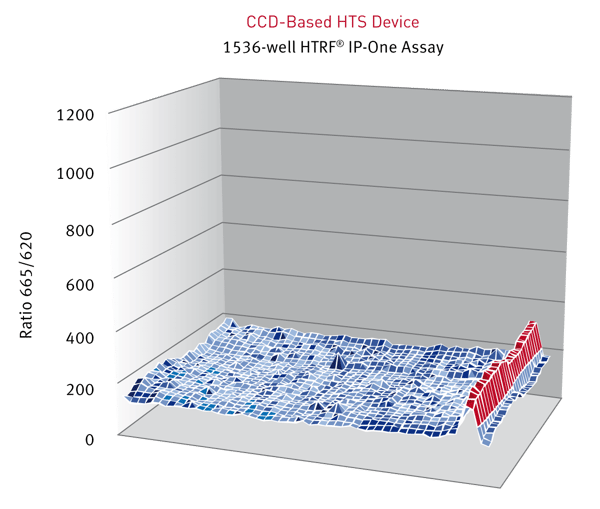
PHERAstar FSX
Powerful and most sensitive HTS plate reader
A tool for running millions of biological or chemical tests in a short time is high-throughput screening. It is mainly used in drug discovery processes to identify biologically relevant compounds. Following you will learn what high throughput screening is, what is required to run high-throughput tests and which assays are primarily used.
 Dr Tobias Pusterla
Dr Tobias Pusterla
High-throughput screening (HTS) is a drug discovery process that allows automated testing of large numbers of chemical and/or biological compounds for a specific biological target, for example through binding assays. High-throughput screening methods are extensively used in the pharmaceutical industry, leveraging robotics and automation to quickly test the biological or biochemical activity of a large number of molecules, usually drugs. They accelerate target analysis, as large-scale compound libraries can quickly be screened in a cost-effective way. HTS is a useful tool for assessing for instance pharmacological targets, pharmacologically profiling agonists, and antagonists for receptors (such as GPCRs) and enzymes.
The primary goal of HTS is to identify through compound library screenings, candidates that affect the target in the desired way, so-called “hits” or “leads”. This is usually achieved employing liquid handling devices, robotics, plate readers as detectors, and dedicated software for instrumentation control and data processing.
 Importantly, high-throughput screening processes do not usually identify drugs, as several properties that are critical to the development of a new drug cannot be assessed by compound library screening. For instance, HTS cannot evaluate toxicity and bioavailability. The primary role of high-throughput screening assays is instead to identify “leads” and provide suggestions for their optimization. The results of HTS assays provide hence the starting point for further steps in the drug discovery pipeline like drug design, and for understanding the interaction or role of a particular biochemical process.
Importantly, high-throughput screening processes do not usually identify drugs, as several properties that are critical to the development of a new drug cannot be assessed by compound library screening. For instance, HTS cannot evaluate toxicity and bioavailability. The primary role of high-throughput screening assays is instead to identify “leads” and provide suggestions for their optimization. The results of HTS assays provide hence the starting point for further steps in the drug discovery pipeline like drug design, and for understanding the interaction or role of a particular biochemical process.
Consequently, high-throughput screening should be seen as a fast scan of biological processes by which compounds with a poor or no effect can be rapidly excluded from the analysis pipeline.
In recent times, HTS was largely enabled by the modern advances in robotics, liquid handling, plate reader detection as well as high-speed computers. Nevertheless, to run effectively, high-throughput screening still requires a highly specialized and expensive screening facility that not every lab can afford. As an alternative to setting up one´s own facility, institutions with limited budgets usually access HTS services provided by third-party providers such as Contract Research Organisations (CRO) or, mainly in an academic environment, core facilities.
Ian Waddell of Charles River Laboratories discusses here what are “the microplate reader requirements of a CRO” for effective hit discovery.
Prof. Christian Heinis from the EPFL in Lausanne makes use of screening in an academic setting to analyse the effectiveness of cyclic peptides as drugs.
In the video below, Mathew Keegan talks about the seamless integration of BMG LABTECH plate readers into Automata´s automation systems.
From a technological point of view, the major points in HTS are miniaturization, automation, and assay readout. Generally, high-throughput screening consists of the following four steps:
Preparation of samples and compound libraries
Samples are usually of cellular or biochemical nature, depending on the assay to be run. High-throughput screening necessitates that samples are prepared in an arrayed format. The key platform or sample carrier used is therefore the microplate. Typical formats include 384-, 1536-, or 3456-well plates. The nature of the sample and of the detection assay may affect the choice of the microplate format and its colour.
Screening facilities usually keep their compound library collections stored in so-called “stock plates”. Stock plates are not directly used in experiments. Instead, when needed, compounds from a stock plate are “copied” to an assay plate through a pipetting station.
Establishment of a method suitable for automation
Automation is an important element in HTS as the conversion of a benchtop to an automated high-throughput screening assay enforces specific constraints affecting the practical assay design. Ideally, a HTS assay is performed in a single well, with a low amount of reagents (miniaturization), and minimal or no further manipulation than injection of the sample/compound to be tested. Accordingly, the choice of the optimal detection mode and assay has to be subordinated to automation issues. For more information on the identification of false positives in screening attempts please see AN 359: Identification of false positives in a HTRF® screen for small molecule inhibitors of PD-1/PD-L1.
Establishing a stringent assay and an effective quality control method are major issues when setting up an automated screen. The clearer the distinction between negative and positive controls, the higher the possibility to obtain high-quality data with a neglectable number of false-negative but especially false-positive results.
Configuration of a robotic workstation
The scope of a robotic platform is to autonomously manage multiple plates simultaneously, significantly speeding up data acquisition. Robotic platforms for high-throughput screenings range from simple automated liquid handling machines to multidimensional workstations performing multiple functions. This is usually achieved with the support of one or more mechanical arms. Typically, a robotic system manages microplates from station to station for several steps such as reagent addition, mixing, incubation, and detection.
In high-throughput screenings data acquisition is usually performed by an optical measurement, quantifying the amount of light “produced” by the sample. Different readouts such as fluorescent or luminescent detection, colourimetry, or light scatter (turbidity) are available. Common detection modes include fluorescence intensity and polarization, FRET, time-resolved fluorescence (e.g.: HTRF®, LANCE®, etc), luminescence (e.g.: NanoBRET), and AlphaScreen®.
Depending on the biological question to be answered, data quality as well as cost-effectiveness, different light-based detection readouts may be chosen. Specialized instrumentation, like multi-mode microplate readers, can sequentially perform different experiments or apply different detection protocols on the wells. The output thereof is a grid of numeric values.
To better understand what are the microplate reader requirements of screening facilities, read here Mark Wigglesworth´s full interview. Mark is Director of High-Throughput Screening at AstraZeneca in the UK and has integrated a PHERAstar FSX in AstraZeneca's screening facility.
 Mark Wiggelsworth, AstraZeneca, UK
Mark Wiggelsworth, AstraZeneca, UK
A HTS-dedicated plate reader can measure hundreds of plates in a single day, generating a considerable amount of data points. Consequently, data management is a critical point in automated high-throughput screening, given the large number of compounds tested, the variety of chemical libraries, and the necessity to correlate and compare results from different screening campaigns. Dedicated data analysis and management platforms (e.g.: Genedata) intertwine data originated from different screening campaigns with compound structures, as well as performed assays to each other, facilitating the extraction of detailed information from different perspectives.
A good example of how the whole high-throughput screening process woks, from assay development to target identification, is discussed in the scientific talk here below.
Compound library screenings have to be usually measured as fast as possible, in very small volumes (a few µL), and produce robust results. Besides the ease of use and flexibility to perform different assays, this requires very sensitive and precise instrumentation. Watch Céline Legros from Servier, France, commenting on her experience with the PHERAstar platform.
Through its past generations, the PHERAstar FSX has been looked at as the reference reader for the field. The following features make it the gold standard for high-throughput screening:
Although one of the most targeted groups of receptors in drug screening is G-Protein Coupled Receptors (GPCRs), not every benchtop assay can be converted to an automated HTS, especially when using living cells. AN287: "NanoBRET assay for monitoring of ligand binding to GPCRs in live cells, using the CLARIOstar and the PHERAstar FS" describes how for the first time NanoBRET was successfully used to monitor ligand-GPCRs binding in living cells.
An important issue in HTS is miniaturisation. Samples have to be as small as possible in order to save costs, but still deliver reliable results. The sensitivity of the microplate reader and its ability to reliably measure samples in high-density plate formats is consequently of great importance. In AN229 "Nano high-throughput screening (nHTS) platform - miniaturization of cell-based GPCR and kinase assays", DiscovereX PathHunter reporter cell lines were measured with the PHERAstar FS in both 1536- and 3456-well plates. The reader was able to detect signals coming from as few as 1,000 cells in a 1,536- and 250 cells in a 3,456-well plate. Similarly, AN260: "Miniaturization of a cell-based TNF-α AlphaLISA assay using Echo liquid handler and the PHERAstar FS" shows how an AlphaLISA assay was miniaturized down to 2 µL per sample in a 1536-well plate and detected on the PHERAstar FS.
In drug screening, speed is as important as miniaturization. AN295: "Cellular and biochemical HTRF assays measured in 1536-well microplates" shows how the PHERAstar FSX equipped with the TRF excitation laser, is able to detect HTRF® assays in 1536-well plates “on the fly” in only 36 seconds, still delivering a Z` value > 0.8.
PHERAstar plate readers are routinely used in HTS facilities as they provide an accurate signal, sensitivity, and high throughput capacity.
The Pivot Park Screening Centre in Oss, the Netherlands, relies on the PHERAstar FSX for effective hit discovery. In our customer success story “Improving hit discovery efficiency at Europe’s leading screening centre”, their CTO, Steven van Helden discusses innovation in drug discovery and the future of screening technology.
In the post „Choosing the best microplate reader“, Mark Wigglesworth, Director High Throughput Screening at AstraZeneca UK discusses the microplate reader requirements needed to keep up with AZ´s screening necessities and why AZ chose the PHERAstar FSX.
Searching for novel kinase inhibitors with the PHERAstar FSX plate reader at BIENTA laboratory in Kyiv, Ukraine. The HTS group screened more than 600,000 compounds in kinase assays using ATP depletion assay, measuring luminescence in a coupled luciferase reaction.
PHERAstar plate readers are routinely used in the laboratory as they provide an accurate signal, high throughput, and sensitivity, as well as stable temperature control required for luminescent kinase assays.
Powerful and most sensitive HTS plate reader
Molecular glues are small molecules that help target unwanted proteins for destruction by the ubiquitin-proteasome system. Find out how microplate readers can advance molecular glue research.
Cannabinoids offer exciting opportunities to target diverse diseases with unmet needs. Learn how microplate readers can help improve our understanding of drug screening and drug signaling events to help advance cannabinoid research.
PROTACs are small, readily designed molecules that target unwanted proteins to the cell’s ubiquitin-proteasome system for degradation. Find out how microplate readers can advance PROTAC research.
Measuring light scattering is an accurate and expedient way to determine drug solubility. Find out how the NEPHELOstar® Plus can be used for early drug solubility screening at high throughput.
Mitochondrial toxicity can have devastating effects on the cell and life. Find out how microplate readers can be used to assess mitochondrial health and how this impacts disease and drug discovery.
The investigation of binding kinetics is crucial for drug research. Find out, how binding kinetics work and which approaches can be used to study them on microplate readers.